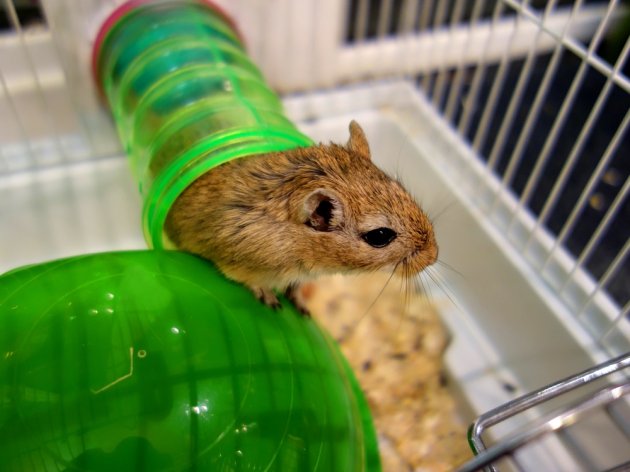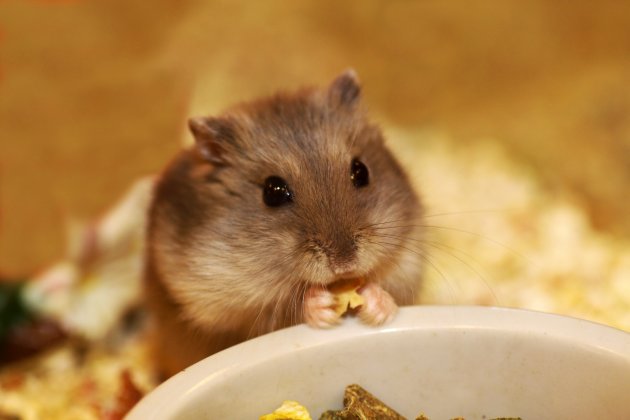They are both small and fluffy rodents, but hamsters and gerbils have way more than that in common. Enough for people to mistake one with the other! If you are struggling to decide for a small pet at home or find it hard to tell the differences between one and the other, here at Pet Comments we’ll help you find the key differences that make each one of these rodents unique.
Appearance
Hamstersare in appearance like any other rodent; they have prominent eyes with big straight ears. A distinctive characteristic that makes hamsters unique is their cheeks. Hamsters have an outpouching in both sides of their mouth; This pouch goes from the corners of their mouth to their shoulders. Hamsters use this “extra space” in their mouth to gather as much food as they can and save it for later.
They have short legs and tail in comparison to their body; they also have glands on both sides of their body which they use to mark their territory.
On the other side, gerbils lack the outpouching that hamsters possess. They have a thinner and larger face in comparison. In the wild, gerbils have a mixture of colors in their coat; gerbils born in captivity are available in different colors due to breeding. Like hamsters, gerbils also have a gland...just not on both sides of their body. This gland is oval shaped and hairless and is located on their abdomen; gerbils use this gland to mark their territory. Unlike hamsters, gerbils do have long tails covered in fur or partially covered depending on the species.

Size
Syrian hamsters are the biggest type of hamster and the most popular ones, too. They measure as long as 13.4 inches from the tip of their head to the tip of their tail in length. Hamsters weigh from 180 to 210 gramsapproximately.
Gerbils are smaller in size in comparison to hamsters, only measuring 6 to 12 inches long. Gerbils are about the size of mice. The male of the species is larger and heavier than the female weighing from 65 to 100 grams and the female weights from 55 to 85 grams.
Food
Both hamsters and gerbils eat essentially the same foods. They can both eat dried mixes and fresh food in a healthy amount based on the nutritional needs of each species. Still, if you have a gerbil, you should buy food especially designed for gerbils not for hamsters. Gerbils have their own nutritional needs, and food designed for hamsters is too high in fat for gerbils to consume.
Hamsters are especially fond of fresh food, but gerbils are native to arid regions; therefore, their stomachs are not well suited for too much fresh food.
Types
You can find a number of 24 species of hamsters in the world. The most common ones used as pets are the Syrian hamster, the Russian hamster, the Dwarf hamster, Roborovski hamster, and the Chinese hamster.
Gerbils belong to a huge family of more than 110 species. Despite this, they lack the variety hamsters have as pets. Only two species of gerbils are known to be used as pets, these are the Mongolian gerbil and the Fat-tailed gerbil.
Gestation period and offspring
The number of pups a hamster gives birth to depends on the species, as well as the gestation period. The Syrian hamster gestation period goes from 16 to 18 days, this period can last till 30 days in other hamster species. Gerbils’ gestation period can last from 21 to 26 days.
Syrian hamsters give birth to a total of 7 pups, other species have smaller litters. The Campbell’s dwarf hamster can have from 7 to 13 pups approximately. Gerbils will mostly have from 3 to 7 pups and the male will start mounting the female almost as soon as she gives birth. For this reason, owners should elude from keeping a male and a female gerbil together or they may end up with a handful of pups.
Interaction
A striking difference between gerbils and hamsters is the way they behave. Gerbils are extremely social and love to be in company; no matter if it is human company or of their own kind. A lonely gerbil is a depressed gerbil. Another element that makes gerbils especially attractive for people is their mild temperament.
Gerbils rarely bite, while hamsters (even when domesticated) tend to be warier and bite more often than their cousins. Hamsters are more territorial and don’t like to share quarters; the Syrian hamster, in particular, is a lonely boy and it likes to be that way.
To aid hamsters into getting along, it is best to raise them together since pups. Once they fully grow into adults more space, separated toys, and quarters are mandatory otherwise they will often fight.

Cage size
The size of the cage can represent a problem for hamsters as they need their own space to play and exercise. A base of 24 inches by 12 inches and a minimum of 12 inches tall is a nice minimum for a hamster. Of course, if you expect to own more than one hamster, extra space must be taken into consideration. Gerbils fit just fine in a cage designed for hamsters. Still, unlike hamsters, gerbils are very committed chewers and not just any cage can contain them. Gerbils need a cage that is chew-proof or they’ll escape easily and get lost in your house.
What about the children?
Gerbils make a wonderful pet for children! Between hamsters and gerbils, gerbils are the most mild-tempered. Another factor that plays in favor of gerbils is that they are super sociable; with hamsters, it may take you a while to earn their trust while gerbils don’t take long to fall for you and your charms.
Children love to play with their pets and can get upset if they are unable to. Hamsters are nocturnal animals, meaning they are the most active during the night. If your child wants to constantly play in the mornings or afternoon it will probably stress the animal if they don’t give it enough time to rest. Gerbils can be nocturnal depending on the species, the Mongolian gerbil, (which is the one most commonly used as a pet) happens to be diurnal...just perfect for the kids!
General habits
As diurnal animals, gerbils will spend their day running, playing and even cuddling if kept in pairs. Hamsters are more lonely and territorial, and since they are nocturnal they will often spend their day sleeping and waking up at times to snack. As nocturnal animals, their nights are the most active.
Conclusion
Hamsters and gerbils certainly look alike and have certain similitudes in food and housing necessities. Yet, they can’t be more different. If you prefer a gerbil or a hamster should depend on your own needs. Do you have time to spend with your gerbil pet during the day? Or is it more likely that you’ll have more free time during the night when your hamster is the most active? Both animals have their own beauty and charm, still, you’ll do well to pick the one that fits better with your routine and circumstances!
References and further readings:
- https://www.msdvetmanual.com/all-other-pets/hamsters/description-and-physical-characteristics-of-hamsters
- Glenway Animal Hospital, Frequently Asked Gerbil Questions
- 100 Fun Facts About Hamsters, Mice, Guinea Pigs, and More by Rose Davidson (Author)